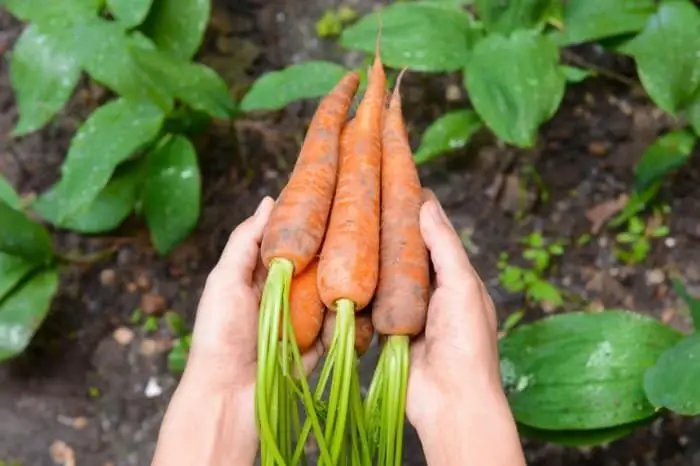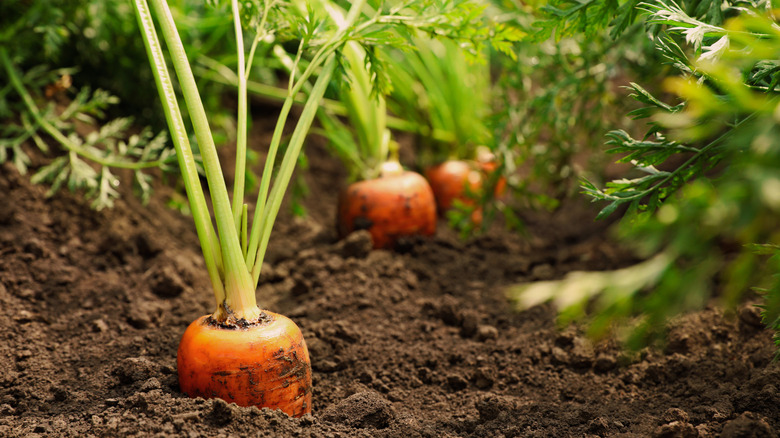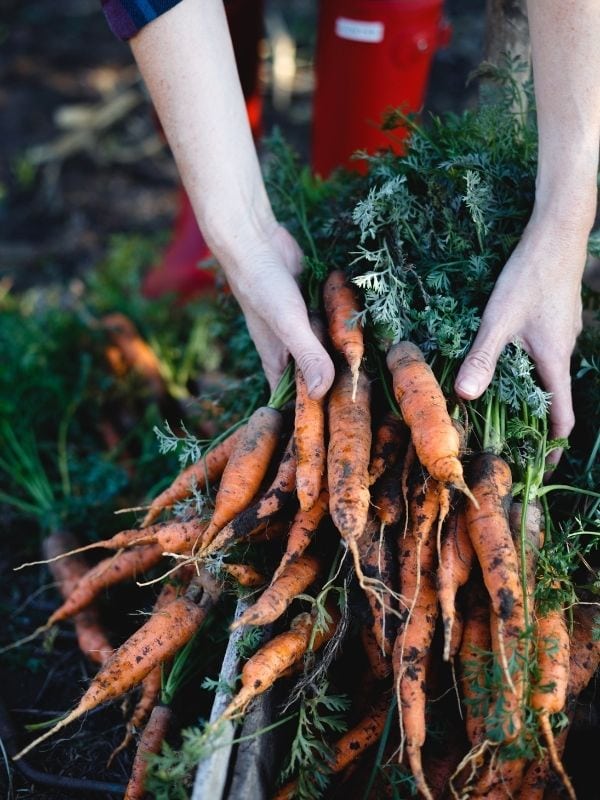Understanding the Signs of Maturity
Harvesting carrots at the right time is crucial to ensure optimal flavor, texture, and nutritional value. Carrots that are left in the ground for too long can become fibrous and bitter, losing their sweetness and crunch. To determine if carrots are ready for harvest, it’s essential to understand the signs of maturity. One of the primary indicators is the size of the carrot. Check the seed package or research the specific variety to determine the expected size at maturity. For most varieties, this is between 1/2 to 1 inch in diameter. Another sign of maturity is the color of the carrot. While some varieties remain green or purple, most carrots turn orange or yellow as they mature.
When checking for size and color, gently brush away the soil around the carrot top to avoid damaging the roots. This will give you a clear view of the carrot’s size and color without compromising its integrity. It’s also essential to consider the days to maturity listed on the seed package. This will give you an estimate of when the carrots are likely to be ready for harvest. However, this is only a guideline, and the actual harvest time may vary depending on weather conditions, soil quality, and other factors.
By understanding the signs of maturity, you can determine if your carrots are ready for harvest. This knowledge will help you avoid harvesting too early or too late, ensuring you enjoy the best flavor and texture of your homegrown carrots. Whether you’re a seasoned gardener or a beginner, knowing how to determine if carrots are ready for harvest is a valuable skill that will enhance your gardening experience.
Checking for Size and Color
When it comes to determining if carrots are ready for harvest, size and color are two important factors to consider. The size of the carrot will depend on the variety, but most carrots are ready to harvest when they reach between 1/2 to 1 inch in diameter. To check the size, gently brush away the soil around the carrot top, taking care not to damage the roots. This will give you a clear view of the carrot’s size without compromising its integrity.
In addition to size, the color of the carrot can also indicate readiness for harvest. While some varieties remain green or purple, most carrots turn orange or yellow as they mature. The exact shade of orange or yellow will depend on the variety, but in general, a deeper color indicates a sweeter and more flavorful carrot. For example, ‘Nelson’ carrots turn a deep orange color when mature, while ‘Danver’ carrots turn a lighter yellow.
It’s also important to note that some carrot varieties, such as ‘Parisienne’ and ‘Thumbelina’, are bred to be harvested at a smaller size. These varieties are often ready to harvest in as little as 50 days and should be checked regularly to avoid over-maturity. By checking the size and color of your carrots, you can determine if they are ready for harvest and enjoy the best flavor and texture.
When checking for size and color, it’s also a good idea to consult the seed package or research the specific variety to determine the expected size and color at maturity. This will give you a better understanding of what to look for and help you avoid harvesting too early or too late. By combining size and color checks with other methods, such as feeling for firmness and shape, you can ensure that your carrots are harvested at the optimal time.
Feeling for Firmness and Shape
In addition to checking the size and color of carrots, feeling for firmness and shape can also help determine if they are ready for harvest. To do this, gently dig around the carrot with a fork, being careful not to damage the roots. As you dig, feel for the firmness and shape of the carrot. A mature carrot should be firm and straight, with no signs of softness or curvature.
When feeling for firmness and shape, it’s also important to check for any signs of damage or disease. If the carrot is damaged or diseased, it’s best to harvest it immediately to prevent the damage from spreading to other carrots. On the other hand, if the carrot is healthy and firm, it can be left in the ground for a longer period of time.
Feeling for firmness and shape can also help you determine if the carrot is ready for harvest by checking its “shoulders”. The “shoulders” of a carrot refer to the area where the carrot meets the soil. If the shoulders are firm and well-defined, it’s a good indication that the carrot is ready for harvest. If the shoulders are soft or undefined, it may be a sign that the carrot needs more time to mature.
It’s also worth noting that some carrot varieties, such as ‘Nelson’ and ‘Danver’, have a more rounded shape than others. In these cases, feeling for firmness and shape may not be as effective, and it’s best to rely on other methods, such as checking the size and color, to determine if the carrots are ready for harvest.
By combining feeling for firmness and shape with other methods, such as checking the size and color, you can get a more accurate idea of when your carrots are ready for harvest. This will help you enjoy the best flavor and texture of your homegrown carrots.
Using the ‘Tug Test’
The ‘tug test’ is a simple and effective method for determining if carrots are ready for harvest. This method involves gently tugging on the carrot top to check if the root comes out of the ground easily. If the carrot comes out of the ground with minimal resistance, it’s likely ready for harvest. If it doesn’t come out easily, it may need more time to mature.
To perform the ‘tug test’, start by locating a carrot that you think may be ready for harvest. Gently grasp the carrot top and give it a gentle tug. If the carrot comes out of the ground easily, it’s ready for harvest. If it doesn’t come out easily, wait a few more days and try again.
It’s essential to be gentle when performing the ‘tug test’ to avoid damaging the carrot or its roots. If you pull too hard, you may damage the carrot or break off the top, which can make it difficult to harvest. By being gentle and patient, you can use the ‘tug test’ to determine if your carrots are ready for harvest.
The ‘tug test’ is a useful method for determining if carrots are ready for harvest, especially when combined with other methods, such as checking the size and color. By using multiple methods, you can get a more accurate idea of when your carrots are ready for harvest, ensuring you enjoy the best flavor and texture.
It’s also worth noting that the ‘tug test’ can be used for other root vegetables, such as beets and parsnips. By using this method, you can determine if these vegetables are ready for harvest, making it easier to enjoy a bountiful harvest from your garden.
Harvesting at the Right Time of Day
When it comes to harvesting carrots, timing is everything. Not only is it essential to harvest carrots at the right stage of maturity, but also at the right time of day. Harvesting carrots at the right time of day can make a significant difference in the quality and flavor of the carrots.
The best time to harvest carrots is typically in the morning or late afternoon when the soil is cooler and more moist. This is because carrots are more likely to be damaged by heat and dryness, which can cause them to become dehydrated and lose their flavor. By harvesting carrots during the cooler parts of the day, you can minimize the risk of damage and ensure that your carrots are at their best.
Harvesting carrots in the morning also allows you to take advantage of the dew that has accumulated on the plants overnight. This dew can help to keep the carrots moist and cool, making them easier to harvest and less likely to be damaged. Additionally, the morning light is often softer and less intense, which can make it easier to see the carrots and avoid damaging them during the harvesting process.
In contrast, harvesting carrots in the heat of the day can be more challenging. The sun’s intense rays can cause the carrots to become dehydrated and more prone to damage, making them more difficult to harvest. Additionally, the heat can cause the soil to dry out, making it more difficult to dig up the carrots without damaging them.
By harvesting carrots at the right time of day, you can ensure that you get the best flavor and texture from your homegrown carrots. Whether you’re harvesting in the morning or late afternoon, make sure to take your time and be gentle when handling the carrots to avoid damaging them.
How to Harvest Carrots Without Damaging the Roots
Harvesting carrots can be a delicate process, and it’s essential to do it correctly to avoid damaging the roots. Damaging the roots can lead to a lower yield and affect the quality of the carrots. Here are some tips on how to harvest carrots without damaging the roots:
Use a fork to gently loosen the soil around the carrot. This will help to avoid damaging the roots and make it easier to lift the carrot out of the ground. Insert the fork into the soil about 6-8 inches away from the carrot and gently rock it back and forth to loosen the soil.
Once the soil is loosened, use the fork to carefully lift the carrot out of the ground. Make sure to lift the carrot by the top, rather than the leaves, to avoid damaging the roots. If the carrot is particularly stubborn, you can use a gentle twisting motion to help loosen it from the soil.
Another important tip is to harvest carrots when the soil is moist. This will make it easier to lift the carrot out of the ground without damaging the roots. If the soil is dry, it’s best to water it lightly before harvesting to make the process easier.
It’s also essential to handle the carrots carefully after harvesting to avoid damaging the roots. Avoid pulling or tugging on the carrots, as this can cause damage to the roots. Instead, gently lift the carrots out of the ground and place them in a container or bag to keep them fresh.
By following these tips, you can harvest your carrots without damaging the roots and enjoy a bountiful harvest of delicious, crunchy carrots.
Common Mistakes to Avoid When Harvesting Carrots
Harvesting carrots can be a straightforward process, but there are some common mistakes to avoid to ensure a successful harvest. One of the most common mistakes is pulling the carrot out of the ground by the leaves. This can cause the carrot to break off at the top, leaving the roots behind. Instead, use a fork to gently loosen the soil around the carrot and lift it out of the ground by the top.
Another mistake to avoid is not harvesting carrots at the right time. Carrots that are left in the ground for too long can become fibrous and bitter, losing their flavor and texture. On the other hand, harvesting carrots too early can result in small, immature roots. To avoid this, make sure to check the carrots regularly and harvest them when they are between 1/2 to 1 inch in diameter.
Not using the right tools for harvesting carrots is another common mistake. Using a tool that is too sharp or too blunt can damage the carrots or the surrounding soil. A fork is the best tool to use for harvesting carrots, as it allows for gentle loosening of the soil without damaging the roots.
Finally, not handling the carrots carefully after harvesting can also lead to damage. Carrots are delicate and can be easily bruised or broken. To avoid this, handle the carrots gently and store them in a cool, dry place to keep them fresh.
By avoiding these common mistakes, you can ensure a successful harvest of delicious, crunchy carrots. Remember to harvest carrots at the right time, use the right tools, and handle them carefully to enjoy the best flavor and texture.
Enjoying Your Freshly Harvested Carrots
Now that you’ve successfully harvested your carrots, it’s time to enjoy them Freshly harvested carrots are a delicious and nutritious addition to a variety of dishes. Here are some suggestions on how to enjoy your freshly harvested carrots:
Use them in salads: Freshly harvested carrots are a great addition to salads, adding a sweet and crunchy texture. Try pairing them with other fresh vegetables, such as lettuce, tomatoes, and cucumbers, and a homemade vinaigrette dressing.
Add them to stews and soups: Carrots are a staple ingredient in many stews and soups, adding a burst of flavor and nutrients. Try adding them to your favorite stew or soup recipe, or experiment with new recipes that feature carrots as the main ingredient.
Enjoy them as a snack: Freshly harvested carrots make a great snack on their own, or paired with hummus or guacamole dip. Try dipping them in a homemade ranch dressing for a tasty and healthy snack.
Use them in slaws and relishes: Freshly harvested carrots can be used to make a variety of slaws and relishes, adding a sweet and crunchy texture to sandwiches, salads, and other dishes.
Freeze them for later: If you have a bountiful harvest of carrots, consider freezing them for later use. Simply chop or slice the carrots, blanch them in boiling water for 2-3 minutes, and then freeze them in airtight containers or freezer bags.
By enjoying your freshly harvested carrots in a variety of ways, you can make the most of your homegrown produce and enjoy the fruits of your labor.








